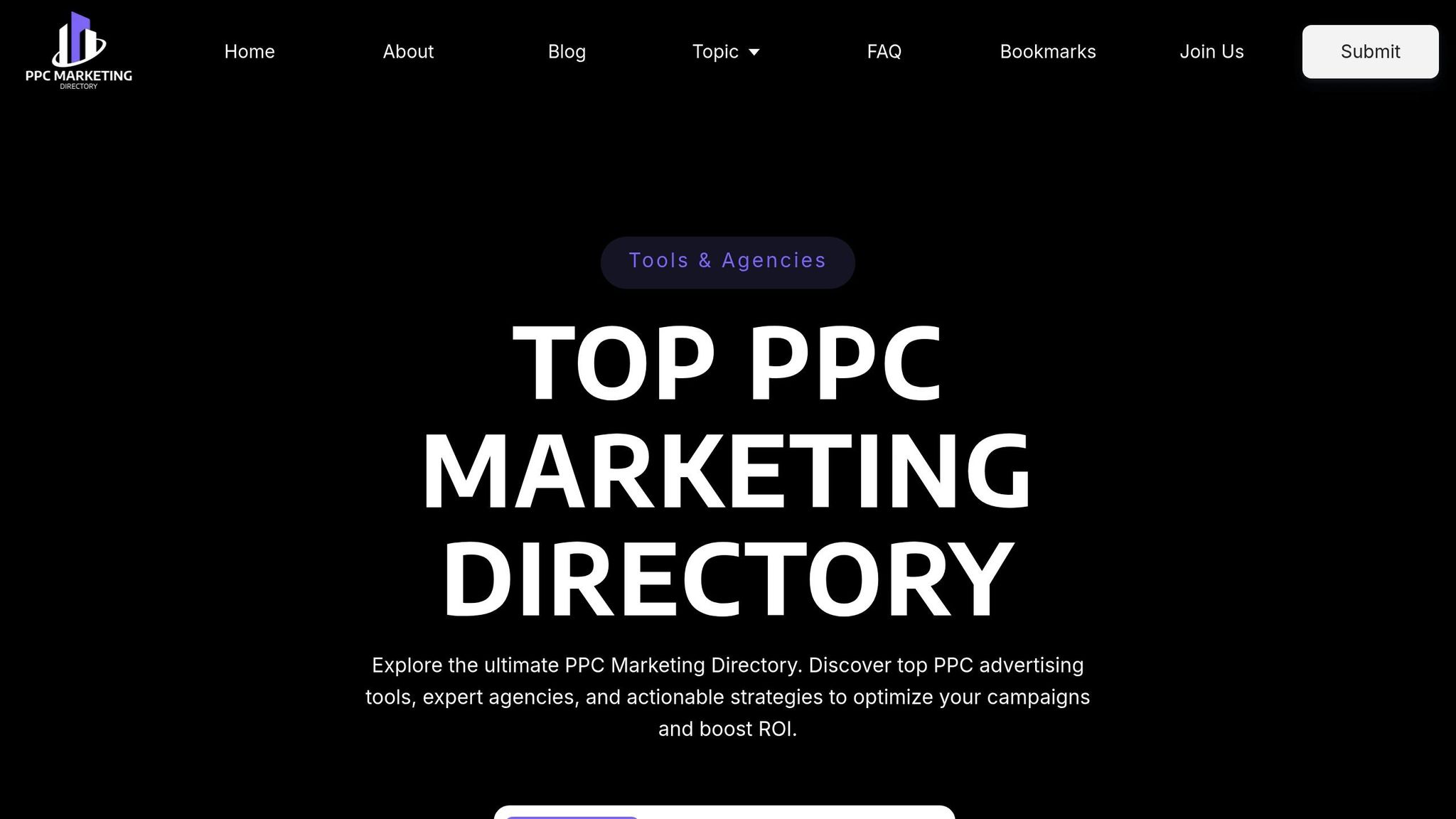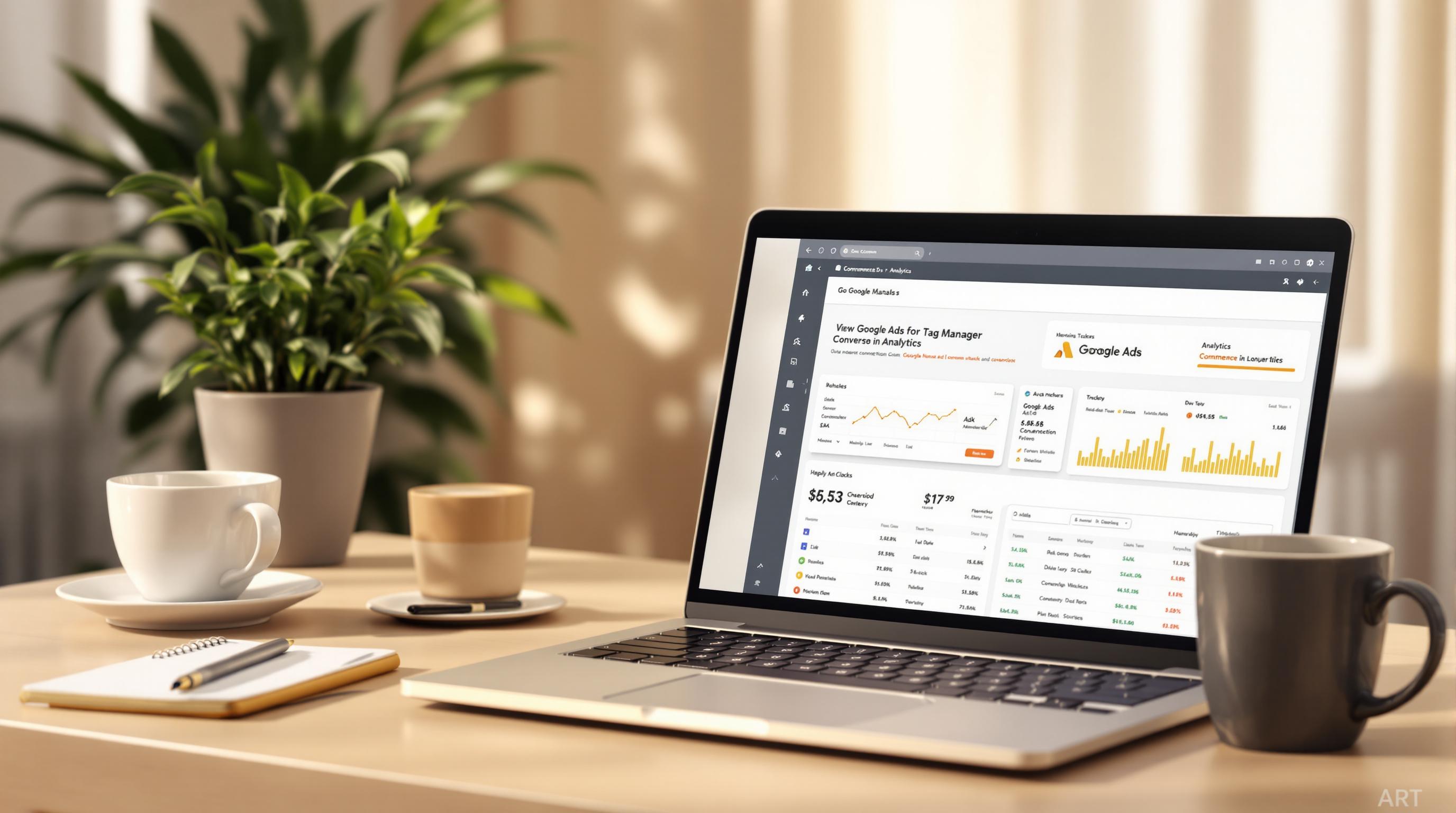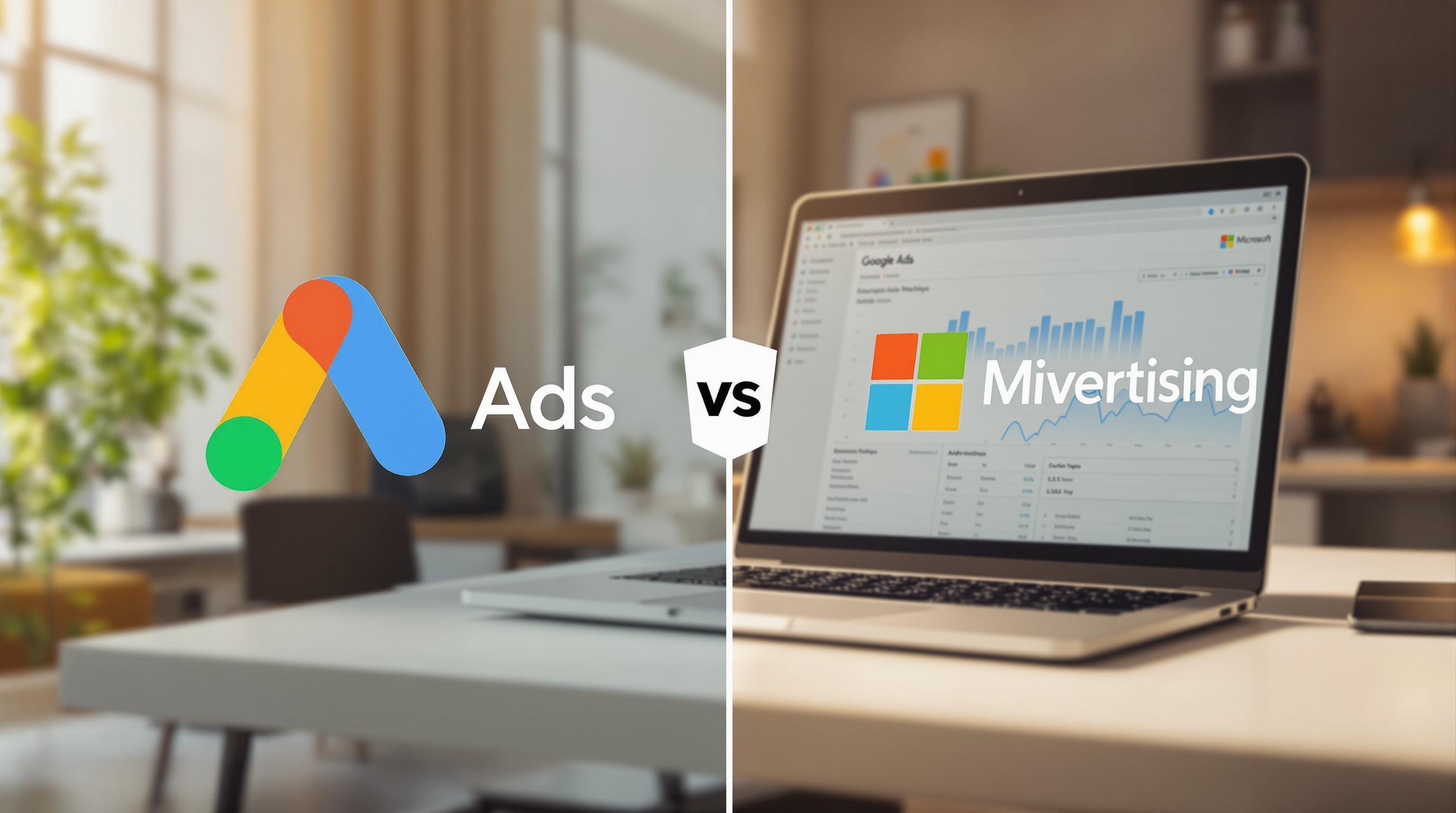Machine learning has completely changed how PPC (pay-per-click) advertising works. Instead of manually adjusting bids, AI now handles this process in real time, improving efficiency and results. Here’s what you need to know:
- Why It Matters: AI-powered bidding can lower costs, increase ROI, and adapt instantly to changes in user behavior or competition.
- How It Works:
- Data Collection: AI analyzes signals like location, time of day, device type, and user intent.
- Model Training: Algorithms learn from past performance to predict future outcomes.
- Real-Time Adjustments: AI updates bids instantly based on live data to maximize conversions.
- Results: Businesses using AI-driven PPC strategies have seen up to a 48% increase in ROAS and significant cost savings.
With tools like Google Ads Smart Bidding and platforms like Optmyzr, machine learning makes PPC campaigns faster, smarter, and more scalable.
How smart bidding really works behind the scenes - Search & Social Advertising Show October 2024
Key Parts of Machine Learning Bid Adjustments
Machine learning bid adjustments rely on three main pillars: data collection, continuous model training, and real-time decision-making algorithms.
Data Collection and Integration
The foundation of effective bid management lies in a strong data infrastructure that pulls together a variety of signals to create a detailed view of each auction.
Google Ads analyzes a wide range of signals to fine-tune bids. These include device type (mobile, desktop, or tablet), physical location (down to the city level), and even location intent - considering where a user might be interested in, not just their current location. Other signals include the day of the week, time of day in the user's local time zone, remarketing list membership, and ad-specific details like mobile app versions.
More advanced signals dive deeper. For instance, the system evaluates the exact search query that triggered the ad (not just the keyword), browser and operating system details, user behavior on the site (like pages visited or progress toward conversion), and product details such as price, condition, and brand for Shopping campaigns. In specialized areas like travel, the system examines factors like hotel ratings, app reviews, price competitiveness, and seasonal trends.
Take, for example, a shoe retailer targeting keywords like "running shoes" or "athletic footwear." They can use geographic targeting to prioritize regions with higher demand and demographic targeting to adjust messaging for different age groups or fitness preferences. This layered approach requires a robust infrastructure capable of processing and integrating all these signals seamlessly.
Model Training and Continuous Learning
Machine learning models are constantly at work, analyzing performance data, predicting outcomes, and making automated decisions to optimize campaigns. These models operate 24/7, tweaking bids, placements, and budgets in real time based on the latest insights.
By leveraging historical data and contextual signals - such as device type, location, and time - these models predict conversion likelihood and adjust bids accordingly. Feedback loops are key, allowing the system to learn from every bid and user interaction, refining future adjustments.
As campaigns evolve and new data becomes available, the models adapt, ensuring bid strategies stay aligned with changing performance trends.
Decision-Making Algorithms
At the core of real-time bid adjustments are advanced algorithms that process data and determine the best possible bid amounts. These systems operate in real time, making decisions about bidding, budget distribution, and ad placement.
Smart Bidding algorithms, powered by machine learning, optimize bids for each auction. Predictive analytics further enhance this process by forecasting potential outcomes, helping guide budget allocation and campaign tweaks. These algorithms also factor in targets like cost per acquisition (CPA) or return on ad spend (ROAS) to align bidding with specific campaign goals.
Different algorithmic techniques - such as Gradient Descent, Stochastic Gradient Descent, Mini-batch optimization, and Adam - are used based on the data volume and performance requirements.
For example, a Target CPA strategy can automatically adjust bids to achieve a specific cost per conversion, such as $50. Similarly, a Target ROAS strategy might aim for a 400% return on ad spend, dynamically applied to campaigns with over 1,000 impressions.
These algorithms work together to process massive amounts of data, learn from ongoing performance feedback, and make split-second decisions that outpace human capabilities. This synergy is what drives the precision and speed of real-time bid adjustments, making them a cornerstone of modern advertising strategies.
How Real-Time PPC Bid Adjustments Work
Real-time bid adjustments happen in the blink of an eye, processing massive amounts of data to fine-tune your campaigns. By understanding how this process works, you can better navigate and optimize your PPC strategy.
Data Signals and Initial Processing
Every time someone searches for a keyword you're targeting, machine learning systems spring into action, analyzing a wide range of signals to calculate the ideal bid. Google's automated bidding, for example, evaluates factors like device type, location, time of day, user behavior, and competitor activity to determine the best bid for that specific auction.
The system digs deep into the details. It considers the device being used, the user’s exact location, the local time, and whether the user is on a remarketing list. It also evaluates more nuanced signals like the browser type, operating system, language settings, and even the intent behind the search query.
AI systems process this data at lightning speed, leveraging historical performance, competitor bids, seasonal trends, and device-specific metrics. Each signal plays a role in shaping the final bid decision, ensuring the system is as precise as possible.
Once the signals are analyzed, predictive models kick in to estimate how likely a user is to convert.
Predictive Modeling for Bid Optimization
After processing the data, predictive models take over to calculate the likelihood of conversion and decide on the optimal bid. Machine learning tools use live data and historical trends to make these decisions in real time.
These models rely on past campaign performance - things like click-through rates, conversion rates, and ROI - to identify patterns and predict future outcomes. They also factor in real-time elements like seasonality and user behavior to refine targeting and improve context relevance.
By grouping users based on shared traits, behaviors, and preferences, these models allow for more personalized messaging. For instance, a telecom company used AI-driven PPC campaigns to capture 48% of its conversions from mobile devices while cutting its cost per acquisition by 36%.
Bid Execution and Feedback Loops
Once the predictive models determine the best bid, the system submits it to the ad auction in real time. But the process doesn’t stop there - automated feedback loops ensure the system continuously learns and adapts.
These loops monitor performance, feeding results back into the system to refine future decisions. Every auction - whether it’s a win, a loss, or a conversion - provides valuable data. This creates a self-improving cycle where the system gets smarter with each interaction.
For example, a fashion retailer running an interactive quiz campaign saw a 40% boost in engagement and a 25% increase in sales by adjusting bids based on quiz completion rates and how long users spent on the ad.
This constant feedback and adaptation mean campaigns grow more efficient over time. AI systems adjust to changes in market conditions, competitor strategies, and user preferences, ensuring your campaigns stay ahead of the curve.
The impact is clear: automated bidding can reduce ad spend by up to 24% while increasing click-through rates by 28%. These systems can also drive a 25% boost in conversions while cutting overall costs by 15%.
From collecting data signals to executing bids and integrating feedback, this entire process happens thousands of times daily for active campaigns. The speed and precision of real-time bid adjustments make them a critical tool for modern PPC success, far surpassing what manual efforts could achieve.
Comparing Real-Time Bid Management Tools
When it comes to selecting bid management platforms, focus on features that directly influence your campaigns' performance. These features are crucial for a thorough evaluation of real-time bid management tools.
How to Evaluate PPC Automation Platforms
Just like real-time bid adjustments rely on precise algorithms, choosing the right platform requires a careful review of its automation, transparency, and integration capabilities.
Marketers aiming for success often look for automation tools with features like anomaly detection, budget pacing, and conversion-based optimizations.
Cross-platform support is now a must-have as businesses often run campaigns on Google Ads, Microsoft Advertising, Facebook, and Amazon simultaneously. Platforms that allow you to manage bids across all these channels from one dashboard save time and ensure your strategy remains consistent.
| Factor | Why it matters | What to look for |
|---|---|---|
| Automation | Reduces manual effort and optimizes bids in real time | Auto-bid adjustments based on conversion data, anomaly detection, and budget pacing |
| Cross-platform support | Keeps bid adjustments consistent across multiple platforms | Seamless integration with Google, Microsoft, Amazon, and Meta Ads |
| Real-time bid adjustments | Adapts quickly to competition and user behavior changes | Tools that update bids dynamically using real-time data |
| Data insights and reporting | Offers clear, actionable insights for better decision-making | Customizable reports, conversion tracking, and analytics tool integration |
| Budget management and pacing | Ensures steady performance and prevents overspending | Features like budget pacing, forecasting, and balanced spend distribution |
| Ease of use and customization | Simplifies tasks without needing technical expertise | Intuitive dashboards, drag-and-drop interfaces, and customizable rule-based automations |
Algorithm transparency is another key consideration. Some platforms provide full visibility into how their algorithms work, while others operate more like "black boxes", leaving you in the dark about how decisions are made.
Pricing models also vary widely, from affordable subscription plans to performance-based fees tied to your ad spend. Many platforms offer free trials, which are worth exploring before committing to a paid plan.
User ratings can also provide valuable insights. Several platforms maintain high ratings - above 4.0/5 - on review sites like G2 and Capterra, while others fall short.
Lastly, ensure that the platform integrates seamlessly with your existing tools, such as CRM, analytics platforms, or other marketing software. It’s also important to consider your team’s technical expertise and training needs.
How Top PPC Marketing Directory Helps

To simplify the decision-making process, the Top PPC Marketing Directory provides a curated list of vetted tools. This platform is designed to help businesses and marketers discover PPC advertising tools, expert agencies, and services tailored for campaign optimization.
One of its standout features is its focus on bid management as a core category. This allows users to compare solutions that align with their specific needs, eliminating the need to spend hours researching individual platforms. Instead, you get access to a refined selection of tools already assessed for quality and effectiveness.
What makes the Top PPC Marketing Directory unique is its well-rounded approach to PPC resources. Beyond just listing tools, it offers insights into campaign management, A/B testing, performance tracking, and other critical PPC functions. This helps you see how bid management fits into your overall advertising strategy.
The directory also offers tiered listings, ranging from free basic options to premium placements that enhance visibility for top-performing tools. This structure ensures that the best solutions receive the attention they deserve, while still making room for emerging platforms.
For businesses aiming to boost their advertising ROI, this directory is an excellent starting point. With PPC advertising traffic converting 50% better than organic traffic, selecting the right bid management tool can have a significant impact on your bottom line.
sbb-itb-89b8f36
Best Practices for Machine Learning in PPC
To get the most out of machine learning in PPC bid management, it’s essential to follow best practices that align with your business goals. By ensuring your algorithms are built on a solid foundation, you can maximize their effectiveness and avoid costly mistakes.
Ensuring High-Quality Data
The success of any machine learning strategy in PPC starts with clean, reliable data. If your data is flawed - whether due to inaccuracies, duplicates, or missing entries - your algorithms are likely to make poor decisions that could waste your budget.
To maintain data quality:
- Remove irrelevant or duplicate entries, such as outdated conversion tracking data or underperforming keywords.
- Correct syntax issues in UTM parameters and campaign names to ensure consistency.
- Address missing data by either discarding incomplete records or filling gaps using historical averages.
- Validate your data’s accuracy by cross-checking key metrics and applying constraints for data types and ranges.
By investing time in data cleaning and validation, you give machine learning tools the best possible foundation to make informed decisions.
Aligning Automation with Business Goals
Machine learning delivers the best results when it’s tailored to specific, measurable business objectives. Automated bidding strategies, for instance, can be set to prioritize goals like boosting traffic, increasing conversions, or improving return on ad spend (ROAS). Choosing the right strategy - like Target CPA for lead generation or Target ROAS for revenue growth - ensures that algorithms optimize bids effectively.
Neil Patel, Co-Founder of NP Digital, emphasizes this point:
"PPC success isn't just about bidding - it's about a complete search marketing strategy that aligns with your business goals."
For example, PPC.co worked with an apartment complex in Tampa, Florida, in March 2025. By combining Performance Max campaigns with high-intent Search campaigns and setting clear conversion goals, they achieved impressive results: total conversions tripled from 10 to 32, the conversion rate increased by over 300%, and the cost per conversion dropped by 44%. This demonstrates how aligning machine learning with clear objectives can lead to measurable success.
It’s also important to involve key stakeholders - such as finance, sales, and leadership - in setting and reviewing these goals. Objectives may evolve over time, so maintaining alignment across teams is crucial.
Leveraging Expert Tools and Resources
Once you have high-quality data and clear objectives, the right tools and expertise can elevate your machine learning strategies even further. Many advertising platforms already offer AI-powered features to streamline PPC management. For example:
- Google Ads: Smart Bidding and Performance Max campaigns
- Meta Ads Manager: Advantage+ Creative features
For more advanced needs, third-party platforms like Optmyzr, TrueClicks, and Adalysis provide sophisticated bid management tools. These platforms typically cost between $149 and $208 per month for accounts with monthly ad spends ranging from $10,000 to $50,000, offering advanced features that go beyond native platform capabilities.
Chris V., Lead Results Innovation Consultant at WebFX, highlights the growing role of AI in advertising:
"AI and Machine Learning have long been a part of advertising, particularly within Google Ads. With the recent advances, these are becoming more apparent."
Additionally, resources like The Top PPC Marketing Directory can help you find vetted tools and agencies specializing in machine learning for PPC. These resources make it easier to discover solutions for bid management, A/B testing, and performance tracking, ensuring every aspect of your PPC strategy works cohesively.
When using expert tools, remember to monitor your automated systems regularly. Set clear goals, interpret performance metrics carefully, and make informed decisions based on machine learning insights rather than relying solely on automated recommendations. This balanced approach ensures your strategy remains effective and aligned with your business needs.
Conclusion
Machine learning has revolutionized PPC bid management, transforming what was once a manual process into a system of real-time, data-driven optimization. The payoff is undeniable: AI-powered bid strategies can boost click-through rates by as much as 30%. By processing massive amounts of data instantly, these tools not only enhance performance but also eliminate human error and adapt quickly to market shifts.
Jack Hall from Lunio highlights the efficiency of automation:
"PPC automation allows you to tap into economies of scale and leverage historic conversion data to expand campaigns almost instantly. Simply select your automated bidding strategy, your target return on ad spend, and let the algorithm do the rest."
The results speak for themselves. Case studies, such as those featuring a telecom company and an e-commerce brand, reveal how automation has driven measurable improvements in campaign performance. These examples set the benchmark for staying competitive in today’s PPC landscape.
But automation isn’t just about better metrics; it’s reshaping the role of PPC specialists. Diana-Alina Aldea from Creatopy explains:
"Before, being a stellar performer was enough to excel as a PPC specialist. Now you are also required to be a great strategist, and automation helps you with that. So don't get bogged down in manual tasks, embrace the possibilities of automation and direct your energy towards creativity, A/B testing, optimization, and data analysis."
To succeed with machine learning, businesses need the right tools. Platforms like Optmyzr, Adalysis, Google Ads, and Microsoft Advertising offer varying levels of automation to suit different needs. For those looking to explore their options, The Top PPC Marketing Directory provides a curated list of bid management tools, agencies, and platforms to simplify campaign management, performance tracking, and A/B testing.
As PPC evolves, those who embrace machine learning while maintaining strategic oversight will lead the way. With 65% of high-intent searches resulting in clicks on PPC ads, manual processes simply can’t keep up. The ability to adapt in real time, combined with clear goals and quality data, is essential for achieving the precision, speed, and scale that modern PPC campaigns demand.
FAQs
How does machine learning optimize PPC bids to improve ROI and control costs?
How Machine Learning Improves PPC Bids
Machine learning takes the guesswork out of PPC bidding by processing massive amounts of real-time data, like user behavior, device preferences, time of day, and competitor activity. With this information, it makes dynamic bid adjustments that ensure your ad budget is spent wisely, reaching the right audience at the perfect moment - all without constant manual intervention.
By automating the bidding process, machine learning allows businesses to manage budgets more efficiently, forecast campaign results, and boost returns. This technology simplifies bid management, delivering stronger campaign performance and a higher ROI, while also saving valuable time and effort.
What factors do machine learning algorithms use to adjust PPC bids in real time?
Machine learning algorithms take the guesswork out of managing PPC bids by analyzing a range of factors and adjusting them in real time. Here's how they fine-tune your campaigns:
- User location: Bids are tailored to match performance trends in specific geographic areas.
- Time of day: Adjustments are made to capitalize on peak engagement hours.
- Device type: Whether it's desktop, mobile, or tablet, bids are optimized for the device being used.
- User behavior: Browsing history and intent signals help guide bid strategies.
- Audience demographics: Factors like age, gender, and interests are used to target the most relevant groups.
- Seasonality: Campaigns adapt to shifts in demand during holidays or special events.
- Ad performance history: Insights from previous campaigns shape smarter bidding decisions.
By constantly analyzing these elements, machine learning ensures your campaigns stay efficient and effective, helping you connect with the right audience while keeping costs under control.
How can businesses use machine learning to align PPC strategies with their marketing goals?
Aligning Machine Learning-Driven PPC Strategies with Marketing Goals
To make the most of machine learning in pay-per-click (PPC) campaigns, businesses need to start with specific, measurable goals. Whether it’s driving more conversions, improving ROI, or cutting down on cost per acquisition (CPA), these objectives act as the backbone of an effective strategy.
Machine learning tools take the guesswork out of optimization by analyzing key performance indicators like click-through rates (CTR), conversion rates, and return on ad spend (ROAS). These tools can then automatically adjust bids and targeting to match campaign goals. By consistently tracking these metrics and fine-tuning strategies based on predictive insights, businesses can ensure their campaigns stay on track. The combination of automation and data-driven decisions makes it easier to boost performance while sticking to clearly defined objectives.


